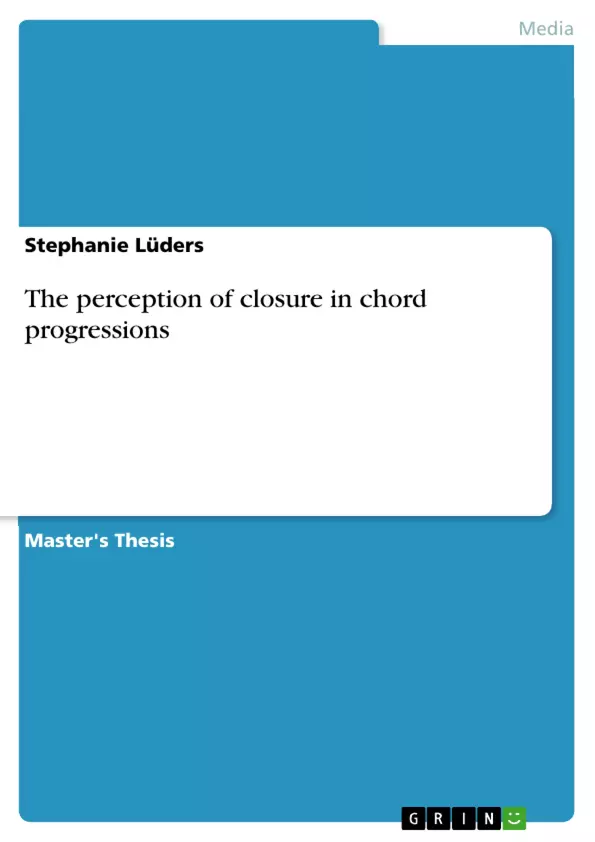Zusammenfassung
Fallende Quinten und Quarten zwischen den Grundtönen aufeinanderfolgender
Akkorde sind die am häufigsten gebrauchten Intervalle in der westlichen Musik.
Sogar zu Zeiten von Palestrina (ca. 1515-1594) waren diese fallenden Intervalle
beliebt obwohl es damals keine Lehre über Musiktheorie gab wie sie heute
unterrichtet wird. Experimente haben gezeigt, dass Zuhörer fallende Quinten im
Vergleich zu fallenden Quarten in der Schlusswirkung bevorzugen (Eberlein 1994).
Das Ziel dieser Arbeit ist dies in einem weiteren Experiment zu überprüfen und es
werden Erklärungen für diese Beobachtungen angestrebt.
In dieser Arbeit geht es um die Wahrnehmung der Schlusswirkung bei Akkordfolgen.
Aus den synthetisch erzeugten Klängen wurden 70 Versuchspersonen 96
Akkordfolgen von jeweils zwei aufeinander folgenden Akkorden vorgespielt. Es gab
48 verschiedene Akkordkombinationen, die zweimal durchgespielt wurden, jedoch in
zufälliger Reihenfolge. Die Akkorde bestanden aus Dur- und Molldreiklängen.
Die Versuchspersonen stellten sich vor, dass die gehörten Akkorde das Ende eines
Musikstücks darstellen. In diesem Sinne mussten die Versuchspersonen die
Schlusswirkung dieser beiden Akkorde bewerten. Es wurde angenommen, dass die
Versuchspersonen fallenden Quinten eine höhere Schlusswirkung zuordnen als
fallenden Quarten.
Insgesamt wurde herausgefunden, dass fallende Quinten eine größere
Schlusswirkung haben als fallende Quarten. Dies gilt allerdings nur für die
Akkordfolgen „Dur-Moll“ und „Dur-Dur“. Eine mögliche Erklärung dafür wäre, dass die
Dominante meistens in Dur steht und die Tonika meistens in Dur oder in Moll steht.
Dies ist vermutlich auf Aspekte der Vertrautheit zurückzuführen und würde
bestätigen, dass vertraute Akkordfolgen größere Schlusswirkung haben.
Inhaltsverzeichnis (Table of Contents)
- 1. Introduction
- 1.1 Aim
- 1.2 Music theoretical background
- 1.2.1 Chord Progressions
- 1.2.2 Cadences
- 1.2.3 Music theoretical developments in history
- 1.2.3.1 Medieval Ages (500-1400)
- 1.2.3.2 Renaissance Period (1400-1600)
- 1.2.3.3 Baroque Period (1600-1750)
- 1.2.3.4 Classical Period (1730-1820)
- 1.2.3.5 Romantic Period
- 1.2.3.6 20th Century Music
- 1.2.4 The circle of fifths
- 1.2.5 OCTS
- 1.3 Literature Overview
- 1.3.1 Riemann and Hauptmann
- 1.3.2 Schmuckler and Piston
- 1.3.3 Bharucha and Krumhansl
- 1.3.4 Rosner and Narmour
- 1.3.5 Eberlein and Fricke
- 1.3.6 Huron
- 1.3.7 Parncutt
- 2. Experiments
- 2.1 Introduction to two experiments
- 2.2 Palestrina's analysis
- 2.2.1 Palestrina
- 2.2.2 Palestrina background
- 2.2.3 Palestrina Style
- 2.2.4 Analysis of Palestrina's 1st Motet in "Canticum Canticorum"
- 2.3 Listening experiment: Closure in two-chord progressions
- 2.3.1 Introduction
- 2.3.2 Method
- 2.3.3 Apparatus
- 2.3.4 Design
- 2.3.5 Procedure
- 2.3.6 Results
- 2.3.7 Conclusion of the experimental data
- 2.3.8 Theoretical Predictions
- 3. Conclusion
- 4. Discussion, Limitations and Relevance
- 4.1 Discussion
- 4.2 Limitations and Relevance
Zielsetzung und Themenschwerpunkte (Objectives and Key Themes)
This master's thesis investigates the perception of closure in chord progressions. It aims to determine if the amount of common tones in a chord progression plays a significant role in creating a sense of closure. The thesis utilizes both theoretical analysis and experimental methods to explore this question.
- Perception of Closure in Chord Progressions
- Influence of Common Tones on Closure
- Music Theoretical Development and History
- Experimental Design and Data Analysis
- Theoretical Predictions and Discussion
Zusammenfassung der Kapitel (Chapter Summaries)
The introduction presents the research question and provides a comprehensive background on chord progressions, cadences, and music theoretical developments across different historical periods. It also includes a literature overview, examining the contributions of various researchers to the understanding of closure in music.
The second chapter focuses on the experiments conducted for this thesis. It begins with an introduction to the two experiments, followed by an analysis of Palestrina's first motet in "Canticum Canticorum," which serves as a historical reference point for the analysis of closure. The listening experiment, described in detail, explores the perception of closure in two-chord progressions, presenting the methods, apparatus, design, procedure, results, and conclusions.
The third chapter concludes the thesis, summarizing the findings and emphasizing the main contributions of the research.
Schlüsselwörter (Keywords)
The primary keywords of this thesis include chord progressions, closure, common tones, music theory, historical analysis, experimental design, perception, listening experiment, and Palestrina. It explores the relationship between theoretical music concepts and their perceived effect on listeners, contributing to the understanding of how music creates a sense of completion and closure.
- Quote paper
- M.A. Stephanie Lüders (Author), 2011, The perception of closure in chord progressions, Munich, GRIN Verlag, https://www.grin.com/document/191295



